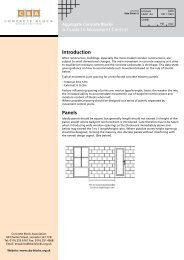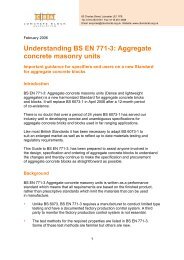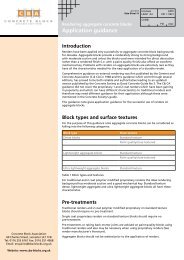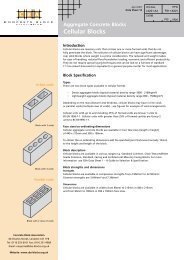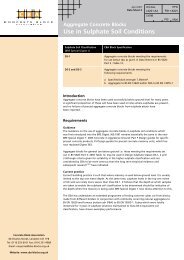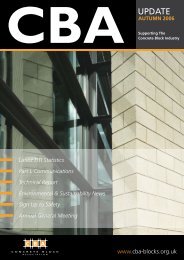Introduction Life Cycle Principles Embodied carbon - Concrete Block ...
Introduction Life Cycle Principles Embodied carbon - Concrete Block ...
Introduction Life Cycle Principles Embodied carbon - Concrete Block ...
You also want an ePaper? Increase the reach of your titles
YUMPU automatically turns print PDFs into web optimized ePapers that Google loves.
February 2013<br />
Data Sheet 16<br />
Uniclass<br />
L3221 :A4<br />
EPIC<br />
F611 :X221<br />
Aggregate <strong>Concrete</strong> <strong>Block</strong>s<br />
Aggregate <strong>Block</strong> Sustainability<br />
CI/SfB<br />
Ff2<br />
(Ajv)<br />
<strong>Introduction</strong><br />
Aggregate concrete block construction and CBA members provide a valuable<br />
contribution to the creation of a more sustainable built environment through the<br />
development of low <strong>carbon</strong> construction, efficient use of resources and providing<br />
durable, cost-effective construction solutions.<br />
There is a range of assessment methods, standards and regulations available to help<br />
gauge the extent to which materials and construction projects are sustainable when<br />
considered against the three pillars of sustainability ie environmental, social and<br />
economic aspects. It is now widely accepted as being essential for sustainability to be<br />
judged using life cycle principles.<br />
<strong>Life</strong> <strong>Cycle</strong> <strong>Principles</strong><br />
To ensure long-term performance, all buildings and structures should be looked<br />
at over their full life cycle from initial concept, through design, construction and<br />
in-service use to end of life. Constituent materials and products should be evaluated<br />
on the same ‘cradle to grave’ basis and their contribution to the project optimised over<br />
its whole life. Such <strong>Life</strong> <strong>Cycle</strong> Analysis (LCA) is the basis of a new European Standard 1<br />
that will increasingly govern how product environmental impacts are evaluated,<br />
reported and potentially regulated.<br />
<strong>Concrete</strong> <strong>Block</strong> Association<br />
60 Charles Street, Leicester LE1 1FB<br />
Tel: 0116 253 6161 Fax: 0116 251 4568<br />
Email: enquiries@cba-blocks.org.uk<br />
Manufacture and delivery of aggregate concrete blocks:<br />
• CBA members’ production plants are situated in the UK and use locally sourced<br />
materials.<br />
• Many aggregate concrete blocks are manufactured using recycled materials.<br />
The average recycled content of an aggregate concrete block is 24% 2 .<br />
• The cement content of aggregate concrete blocks is low, at 89Kgs/tonne 2 .<br />
• The average percentage of alternative cements, e.g. fly ash and ground granulated<br />
blast furnace slag, is 19% of all cements used.<br />
• The energy required to manufacture concrete blocks is only 21 kW/tonne 2 .<br />
• This energy consumption equates to 6 kg/tonne 2 of CO 2<br />
emissions.<br />
• Water consumption in concrete block manufacture averages 39 litres/tonne 2 .<br />
• Waste generated in concrete block manufacture is less than 2% 2 , packaging is<br />
minimal and most production waste is crushed and re-used in the factory.<br />
• Almost all concrete block manufacturers are certified to EN 14001.<br />
• BRE Standard BES 6001 is the main standard by which construction products can be<br />
verified as responsibly sourced. Many aggregate concrete blocks are independently<br />
certified to BES 6001 3 .<br />
• With over 100 aggregate concrete block plants in the UK average delivery distances<br />
are c. 30 radial miles.<br />
<strong>Embodied</strong> <strong>carbon</strong><br />
The degree to which product groups contain embodied <strong>carbon</strong> is not yet an exactly<br />
defined science and perhaps will always be subject to some interpretation and<br />
discussion.<br />
However one of the most respected and freely available sources of information on a<br />
wide range of materials is that published by Bath University, entitles University of Bath,<br />
Inventory of Carbon and Energy. It is widely known and referred to as the “Bath ICE” 9 .<br />
The Bath ICE lists inter alia embodied <strong>carbon</strong> expressed as kgs CO 2<br />
/kg of material on a<br />
cradle to gate basis.<br />
Version 1.6a – Material Profile : <strong>Concrete</strong> contains reference to aggregate<br />
concrete blocks.<br />
Website: www.cba-blocks.org.uk
This table lists aggregate blocks up to 8MPa as having embodied <strong>carbon</strong> of 0.061 kgs<br />
of CO 2<br />
/kg of concrete. The great majority of concrete blocks are 7.3 MPa and below so<br />
this is a fair approximation for aggregate concrete blocks in general.<br />
The embodied <strong>carbon</strong> level for aggregate concrete blocks is surprising low, this<br />
is because :-<br />
• Strengths are usually comparatively low though fit for purpose as strength<br />
demanded is usually compressive<br />
• Low levels of cement are required due to the low water: cement ratio in<br />
manufacture, this is facilitated by employing high levels of vibration in the block<br />
making machine<br />
• On average aggregate concrete blocks contain aggregate of which 24% is recycled<br />
and cement of which 19% is defined as cement replacements<br />
Listed below are some materials for comparison purposes. It can be seen that<br />
aggregate concrete blocks compare very favourably with a variety of common<br />
construction materials.<br />
Cradle to gate embodied <strong>carbon</strong><br />
Material<br />
Kgs CO 2<br />
/kg of material<br />
8 MPa aggregate concrete block 0.061<br />
Autoclaved aerated concrete<br />
0.28 – 0.375<br />
blocks (aircrete)<br />
Sawn softwood 0.45<br />
Plywood 0.81<br />
Steel – UK typical 1.77<br />
General plastic 2.53<br />
Note that the above products have different densities and that values for timber<br />
products exclude the calorific value (CV) of the wood<br />
Source : University of Bath Inventory of <strong>Embodied</strong> Energy (2008) Vers 1.6a<br />
Construction:<br />
• Based on reliable techniques that have been established over many years,<br />
aggregate block construction has introduced buildable innovations to improve<br />
performance to meet developing requirements.<br />
• The range of dimensions, strengths and surface textures, widely available from<br />
stock or with short delivery times allows flexibility and optimisation to meet<br />
project requirements.<br />
• Aggregate concrete blocks use the minimum amount of packaging consistent with<br />
providing safe delivery and handling.<br />
• Construction techniques and block weights have been developed to ensure that<br />
site handling operations are safe and minimise the potential for injury to site<br />
personnel.<br />
• A block built building will last more than 150 years.
In-Use performance:<br />
• External and separating/party wall thermal insulation solutions are available that<br />
contribute significantly to meeting Building Regulations thermal requirements and<br />
the future development of zero <strong>carbon</strong> construction 4 .<br />
• External cavity walls can be built with aggregate concrete blocks to U-values of 0.18<br />
using conventional designs and cavities of between 100mm and 150mm depending<br />
on the type of insulation specified. Lower U-values can be achieved by either raising<br />
the quality of insulation and/or its thickness.<br />
• Thermal mass effects provide more efficient long term energy/<strong>carbon</strong> performance<br />
than lighter weight construction 5 .<br />
• Aggregate blocks are durable, fire resistant, not attacked by vermin or insects, do not<br />
introduce harmful substances into the internal environment of buildings and require<br />
minimal maintenance over the full life of the building. <strong>Block</strong> construction is resistant<br />
to flooding, a potentially increasing risk in the UK due to climate change.<br />
• The BRE Green Guide to Construction provides environmental performance ratings<br />
for typical UK constructions on the basis of A+ to E ratings. Many aggregate block<br />
constructions are at the higher performing A and A+ ratings 6 .<br />
• The Code for Sustainable Homes 7 and the BRE Environmental Assessment Method<br />
(BREEAM) 8 are currently the most commonly used sustainability assessment methods<br />
in the UK. Aggregate block construction attracts high levels of credits for:<br />
– Thermal performance (within Energy and Carbon).<br />
– Acoustic performance (within Health and Wellbeing).<br />
– Environmental performance ( due to high Green Guide ratings).<br />
– Responsible sourcing of materials (through ISO 14001 and BES 6001 certification).<br />
End of <strong>Life</strong>:<br />
• Buildings constructed with aggregate concrete blocks can be easily modified to<br />
extend their life and to accommodate the developing needs of occupiers or for a<br />
change of use.<br />
• <strong>Block</strong>s are fully recyclable e.g. as a source of aggregate for future construction.<br />
References/Links<br />
1. BS EN 15804:2012 “Sustainability of construction works. Environmental product<br />
declarations. Core rules for the product category of construction products”<br />
2. British Precast Sustainability Charter. Independently audited annual returns<br />
representative of 60% plus of UK manufactures aggregate concrete blocks<br />
http://www.britishprecast.org<br />
3. BRE BES 6001 “Framework standard for the Responsible sourcing of construction<br />
products”<br />
http://www.greenbooklive.com/search/scheme.jsp?id=153<br />
4. CBA data sheets ‘External insulation of solid walls’ and ‘External walls thermal<br />
performance’.<br />
www.cba-blocks.org.uk<br />
5. “A whole life CO2 argument for concrete blocks” Tom de Saulles CBA Spring 2012<br />
Newsletter<br />
www.cba-blocks.org.uk<br />
6. BRE Green Guide to Construction<br />
http://www.bre.co.uk/greenguide/podpage.jsp?id=2126<br />
7. Code for Sustainable Homes<br />
http://www.planningportal.gov.uk/buildingregulations/greenerbuildings/<br />
sustainablehomes/<br />
8. BRE Environmental Assessment Method<br />
http://www.breeam.org/<br />
9. Bath University Inventory of Energy and Carbon<br />
http://www.bath.ac.uk/mech-eng/sert/embodied/




